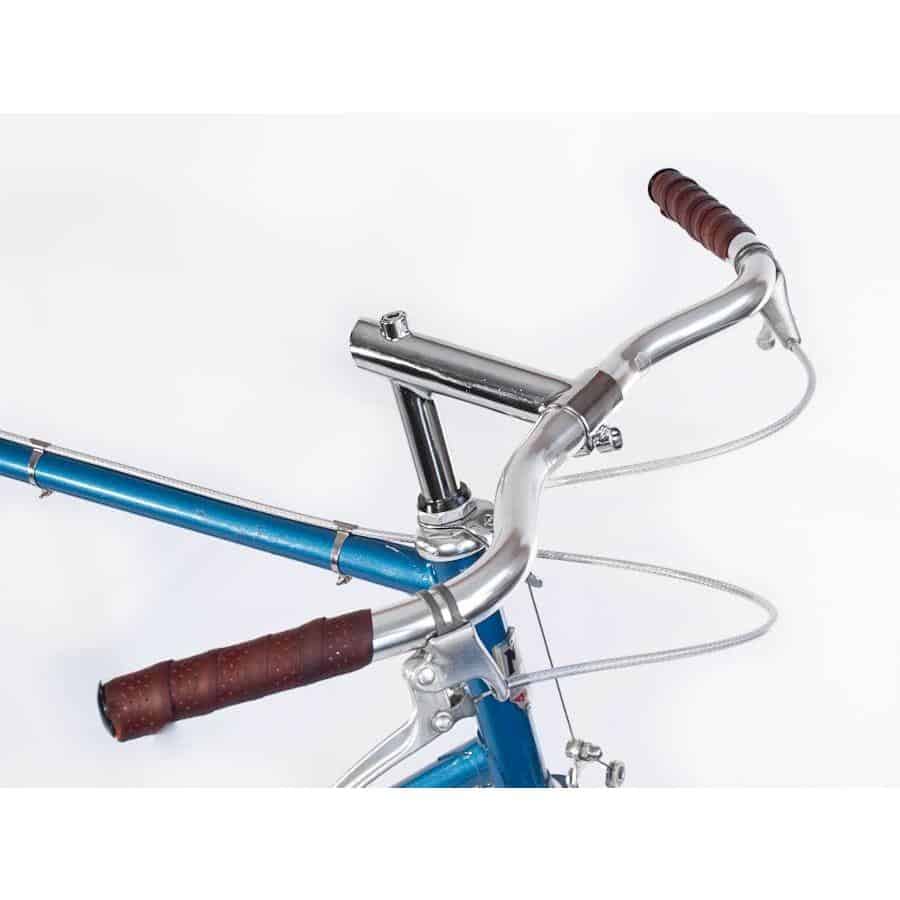Last updated: January 9th, 2023
The choice of handlebars defines your riding experience more than any other single component. There’s an incredible range of handlebar types, but they all broadly fall into three categories.
Swept-back, drop, and flat bars are all used for multiple purposes.
But for utilitarian needs, like commuting, what are you going to happiest with?
This article might contain affiliate links. As a member of programs including Amazon Associates, I earn from qualifying purchases.
In brief: handlebar styles for bike commuting
Swept-back and flat handlebars are optimal for commuting and urban riding. Swept-back bars have a neutral wrist position, and some create an upright posture that is comfortable and easy to see your surroundings from. Flat, straight bars create a slightly more powerful position with excellent control on rough terrain and better leverage when riding out of the saddle.
Drop bars maximize aerodynamics and efficiency, but may be less comfortable, so they’re better for long, high-speed commutes on reasonably smooth routes.
Bullhorn and moustache bars are also worth considering.
There’s no clearly right or wrong choice, since it’s a combination of your flexibility, posture, preferred speed and effort, terrain, and style of bike.
(A quick note on terms: strictly speaking, most “flat” bars actually do rise a few millimeters and sweep (bend) a few degree. But when we look at swept-back bars here, we’re talking about ones that have a significant bend, as in 30-70 degree or even more. They may also rise quite a bit, but not always. These categories aren’t set in stone, but this is how I’ve come to think of them.)
Why swept-back bars are ideal for commuting
While we all like to go fast, it’s important to be comfortable on the way to work. And the surest way to be more comfortable on a bike is to be upright with relaxed wrists.
Here’s a quick experiment: let your arms hang by your sides, and pay attention to your hands. Your palms are probably somewhere between facing each other and 45 degrees away. In any case, they’re not facing backwards with thumbs in line–even though flat bars put your hands in exactly that position!
That parallel or slightly turned angle is the most anatomically neutral hand position. Swept-back handlebars are comfortable because they encourage that rather that prevent it.
Types of swept-back bars
In the big picture, swept-back bars are more or less the same category of handlebars: distinct from drops, flats, and so forth. But digging deeper, there are three major varieties that you’ll run into.
City bikes often use swept-back bars that rise high and reach quite far back toward the rider. These allow for a mostly or completely upright posture.
But that super-upright design is not strictly necessary. In fact, several handlebars still have nice sweep for comfort, but don’t rise or reach back very much. This allows the same basic hand position but a sportier feel, without rising so high or reaching so far.
Finally, some swept-back bars basically match the riding position of flat bars, with barely any rise and practically no extension back toward the rider. They simply rotate the wrists. We’ll see an example of each a little farther down.
First are very upright bars (like the Nitto Bosco). These are extremely comfortable while still giving plenty of room to grip near the stem and lean forward. However, they may be too upright for a sporty bike with a short wheelbase and steep angles.
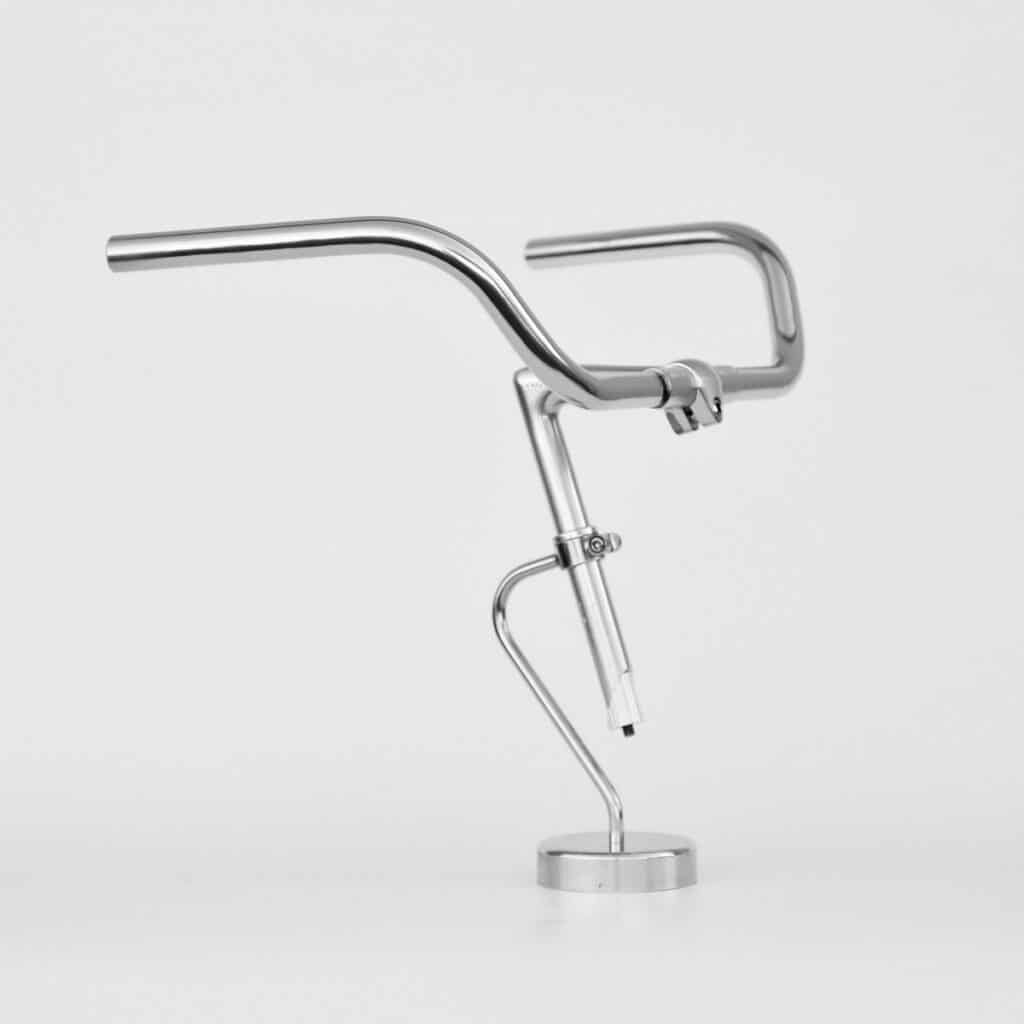
That’s because sitting up shifts your weight over the rear wheel. Some bikes have elongated and relaxed geometry to keep everything balanced, but hybrids and road bikes do not, so excessively upright bars can cause twitchy handling.
Most commuters want to avoid the extremes of uprightness or forward-leaning. So, for commuting, I’m a fan of three middle-of-the-road styles.
One is the Velo Orange Tourist, which draws inspiration from what you’d find on a vintage English roadster. They’re still common on modern hybrid bikes that prioritize comfort but want a sportier feel.
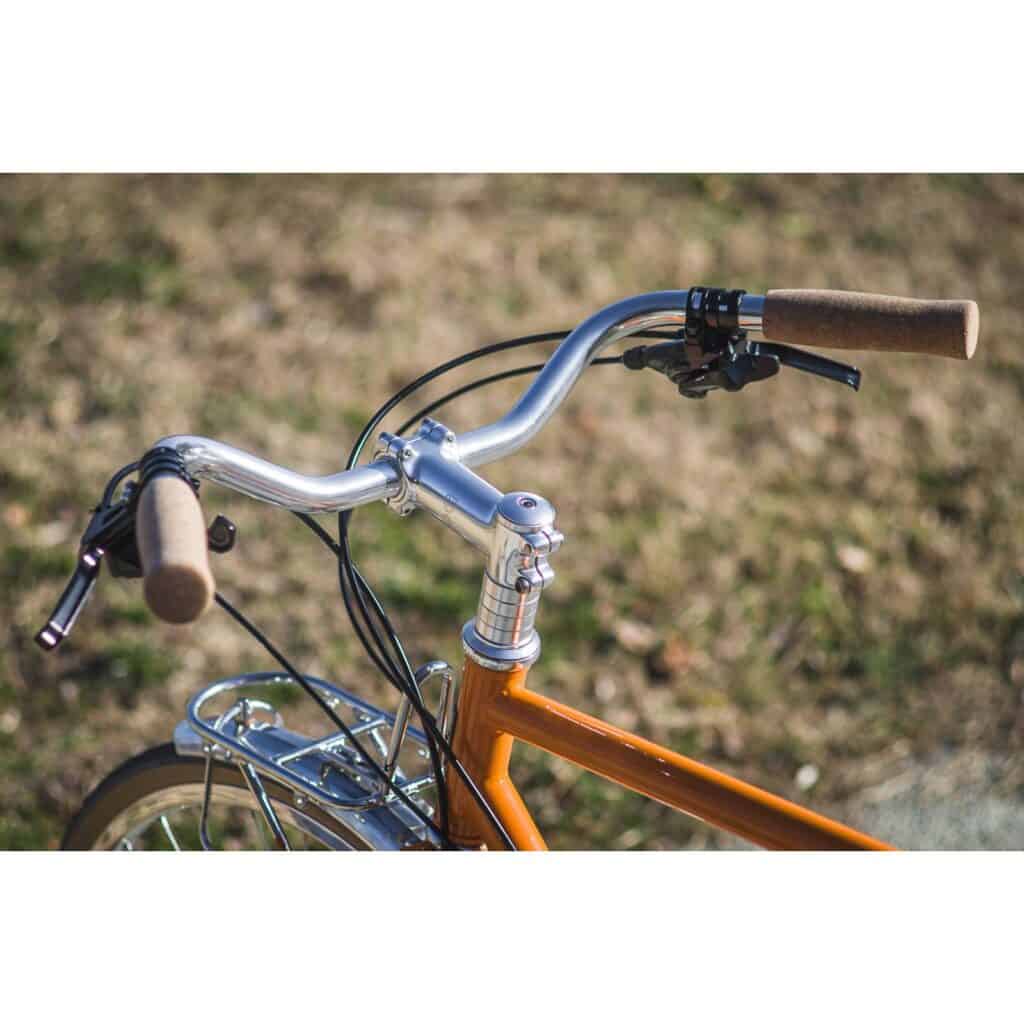
The classic Nitto Albatross sweeps back a little more for uprightness, but the slight bend toward the front makes it easy to get a more aerodynamic posture when you need to. It’s very similar to riding on the hoods of drop bars…except you can still sit back up!
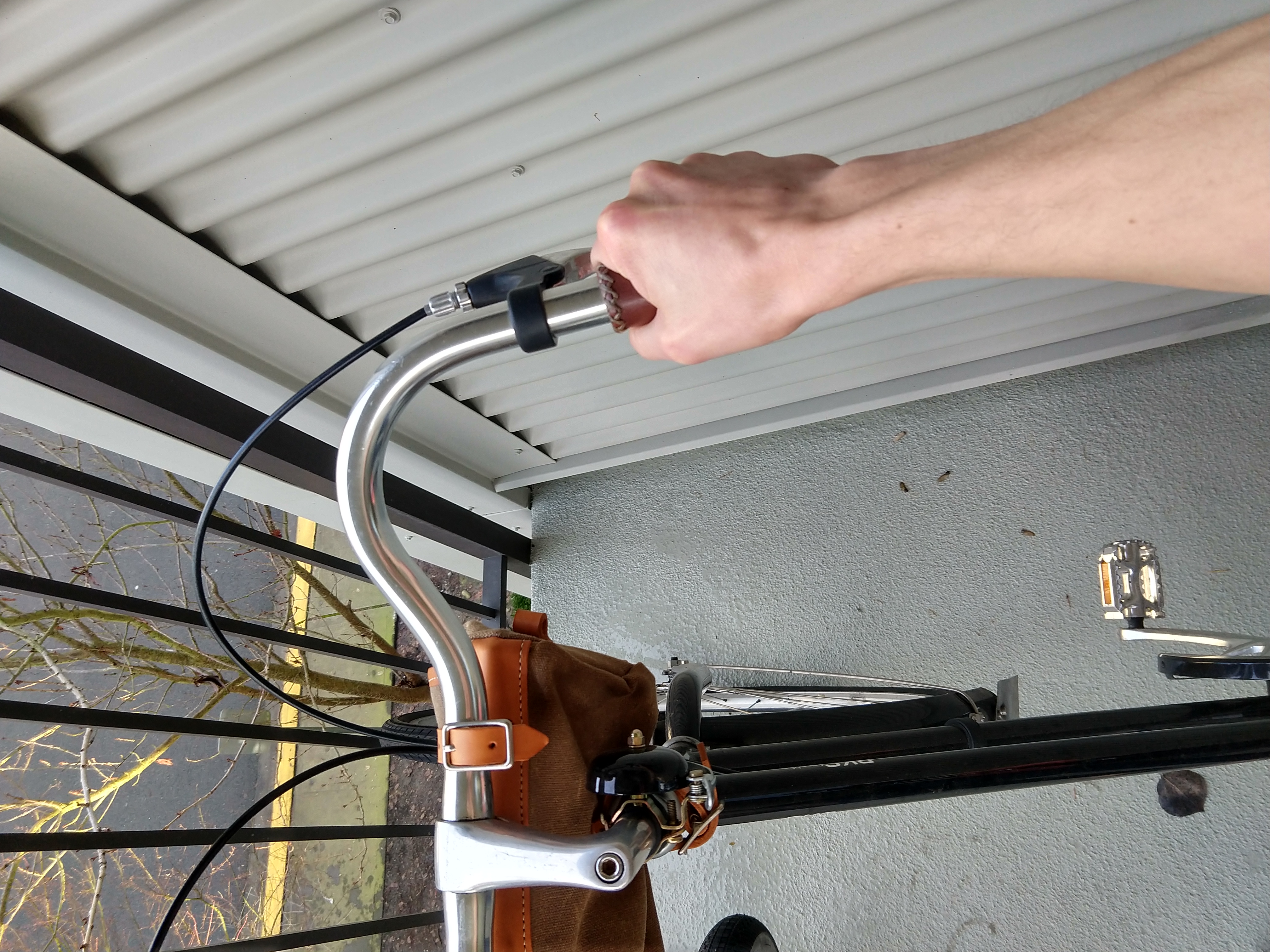
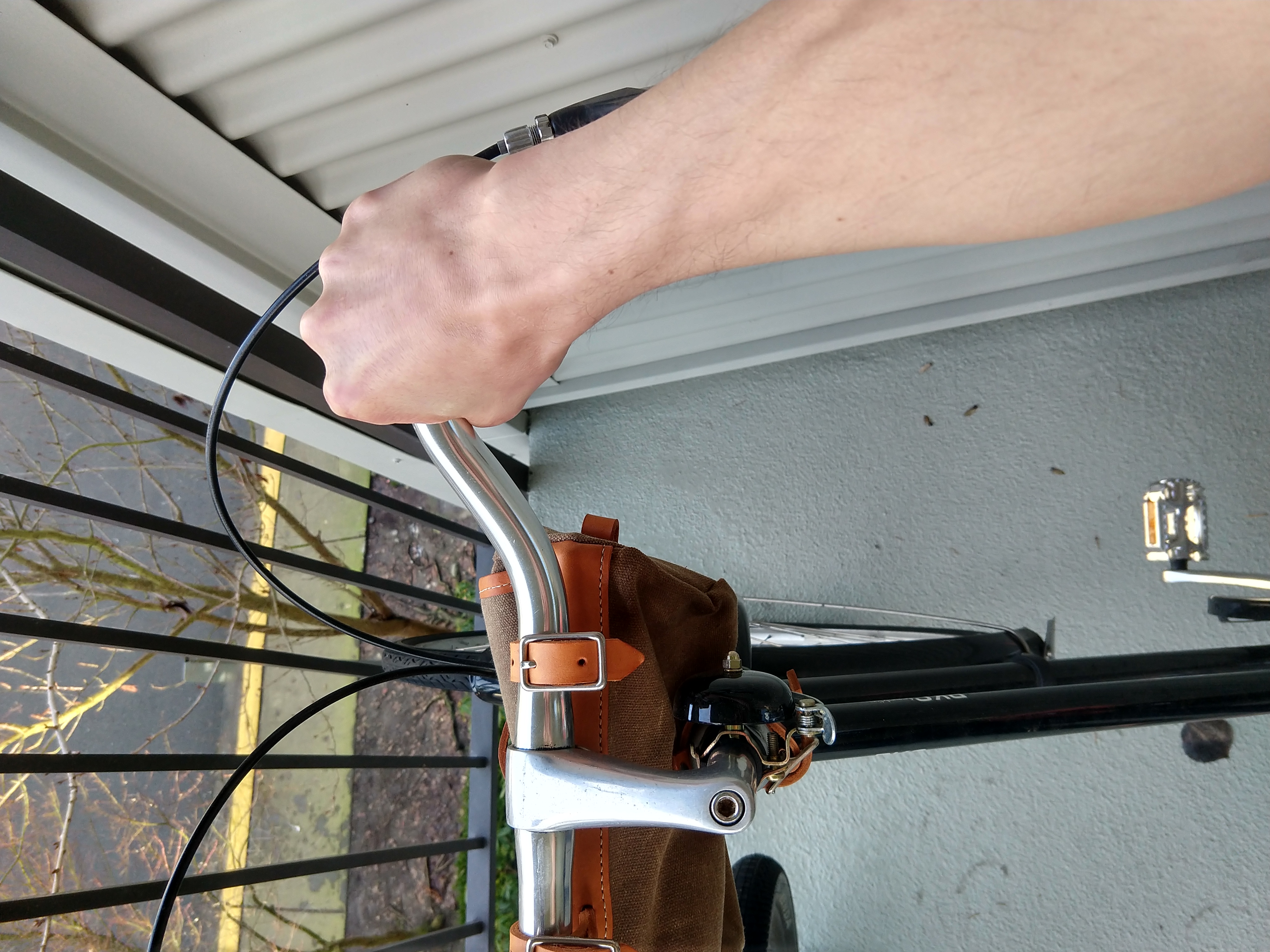
Finally, the Velo Orange Postino has no rise and a short reach, but still a nice hand angle. It puts you in the most forward-leaning posture out of these three. That’s ideal for hybrid bikes or even conversion from drop bars (but see the FAQ for important notes on conversion).
Other brands make similar designs, since handlebar shapes generally aren’t patented. These are just better-known examples from brands I personally use and trust.
Pros
Swept-back handlebars allow a neutral hand position that’s comfortable for everybody. There are many variations for more upright or more forward-leaning upright posture.
Any commuter can find something that feels adequately sporty or relaxed, all with a comfortable grip that avoids wrist strain.
Cons
Upright posture is comfortable but it exposes you to the wind. In some conditions, uprightness forces you to work harder to maintain the same speed. That’s trivial in urban riding but can be a problem if your commute involves long, open stretches.
It’s also harder to engage your glutes fully when you’re sitting straight up. That leaves some power on the table. Again, it’s more important on high-speed stretches (or extended climbs) than in the city.
But remember that while swept-back bars can put you quite upright, they’ don’t have to. If your upright ride feels too inefficiency, simply switch to other swept-back bars that either a) allow a forward hand position near the stem or b) don’t rise or extend back much in the first place.
Tips & suggestions
If in doubt, err on the side of more relaxed bars and simply lean forward when effort or headwinds demand it. Many new commuters think they value speed, only to discover that going a couple mph slower in greater comfort is far more pleasant and sustainable!
Why do commuters like flat bars?
I believe flat bars are so prevalent with bike commuters not because they’re necessarily the most comfortable–swept-back bars take that title–but because they’re the norm on the bikes most commuters choose for other reasons.
For example, hybrid bikes are a very popular choices for commuters, since they balance some of the lightness and efficiency of a road bike with some of the comfort and durability of a mountain bike.
And one of their most obvious mountain bike influences is (generally) handlebars. Some hybrids do use swept-back bars, as mentioned above, but the majority use flat, straight bars (perhaps with a slight rise) like you often see on MTBs.
That said, flat bars do have a couple of unique advantages. Let’s look at what they are and whom they help.
Pros
Flat bars maximize control and leverage when you’re in a somewhat forward-leaning position. And that sort of position is standard on sportier bikes, so flat bars simply make sense. This aggressive geometry and flat bars are a great combination for quick urban riding, with lots of darting between cars and the like.
Wider flat bars give great leverage. This is surprisingly helpful when you need to muscle a bike up sudden and steep inclines. That shows up in urban riding when you’re trying to climb on a single-speed, for instance, and need every inch of leverage you can get to grind out a few more pedal strokes.
Cons
A fairly straight bar isn’t the most anatomically correct. Even some off-road riders have switched to swept-back bars in recent years, thanks to wide and sturdy models like the popular Jones H-Bar.
If you’re prone to wrist pain (as I am), then flat bars are usually less comfortable than drop or swept-back varieties. The latter help in two ways: more upright posture reduces the weight your wrists bear, and more palms-facing grips create a natural and neutral wrist angle.
Tips & suggestions
They’re a good compromise for somewhat performance-oriented riders who don’t want full-on drop bars. They’re characterized by their lack of shape, so options are numerous and fairly interchangeable. But they’re not identical, so you can play around with rise and width to dial in the fit. As mentioned earlier, some flat bars may also have a couple degree of sweep, so that’s another variable to experiment with.
Pro tip: it’s easy to shorten bars with a hacksaw (as long as they’re not carbon!), so don’t hesitate to buy handlebars a little longer than you think you’ll need.
Wrist pain with flat bars is not uncommon. If you encounter it, then consider ergonomic grips like the Ergon GC1 for a very slight adjustment. The Ergon GC3 is similar but with added bar ends for another hand position altogether; you just can’t brake or shift from the bar ends.
If grips don’t relieve your discomfort, then switch to mildly swept-back handlebar (like the Postino, above) that keeps your wrists at a more neutral angle without changing the riding position.
Are drop bars good for commuting?
Drop bars afford several hand positions, some of which are good for commuting and some of which aren’t often helpful. Here are the three main positions:
- In the hooks (the part that actually drops/curves down) for aerodynamic, high-effort riding
- On the hoods (the rubber covers around the hinges of the levers) for general riding
- On the tops (the narrow, flat part near the stem) for uprightness and rest, often on extended climbs when you don’t need to brake or shift
More variations and in-between positions are possible, but it depends on the exact bars and on where your levers and shifters are mounted.
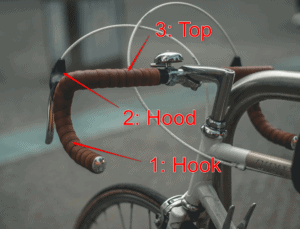
Pros & cons of the hooks
The hooks pull you into a very deep forward bend. That’s extremely aerodynamic because you’re mostly out of the wind. It’s also powerful and efficient, since leaning forward helps you use your glutes more with each pedal stroke. The hand position is neutral (palms facing) and easy to reach the levers from.
However, it’s hard to see around you, and even looking forward causes neck strain for some riders. That’s why commuters with drop bars don’t spend much time in the hooks: often just on high-speed stretches or when fighting a stiff headwind.
Pros & cons of the hoods
The hoods are slightly more upright, with less neck strain. That affords at least a little comfort, as well as a neutral hand position with good access to the levers. Additionally, the hoods are well in front of the steering axis, so handling may feel steadiest there.
From the hoods, you’re gripping near the hinges of the levers, not the ends. That reduces lever, so an emergency stop may be slightly slower. Whether that’s a problem depends on the power and adjustment of your brakes themselves. The calmer handling can also start to feel too relaxed in very tight, technical conditions…but those are not common when commuting.
Pros & cons of the tops
The tops are the most upright position and therefore the most comfortable. Cyclists often use them to sit up and breathe deeply during long climbs.
However, the tops really are best reserved for resting. They’re extremely narrow, so the reduced leverage can make it hard to control the bike around commuting obstacles like traffic and potholes. Perhaps more importantly, you can’t brake or shift from the tops. (Top-mounted brake levers are available, but they’re not common on road bikes.)
Tips & suggestions
Some drop bars have shallower hooks. These are known as compact bars, and they’re more useful for most commuters. A deep, aero posture just isn’t necessary in city riding, so compact bars give a more moderate and comfortable alternative.
Some road cyclists have elaborate ways of choosing drop bars sizes. Personally, I’ve done well just choosing whatever width matches the width of my hands by my size. If in doubt, then I’d lean toward the wider size.
If you like drop bars’ variety of hand positions, but want to sit slightly more upright on your commute, then try the Nitto Moustache or Albastache. They’re essentially drop bars with the hooks flared up and out–like Salsa Woodchippers, but more extreme.
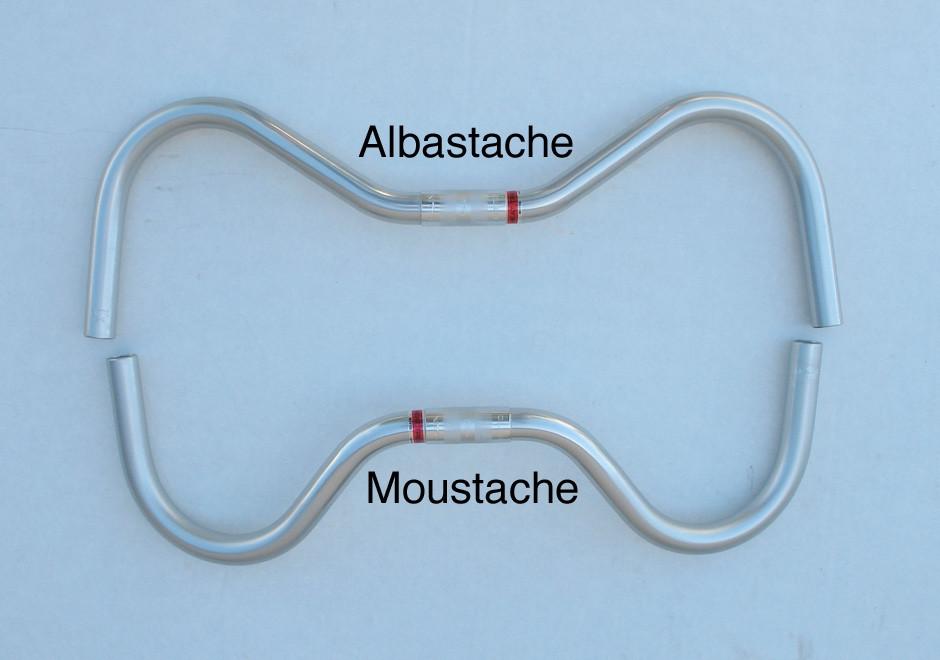
Those keep the neutral hand position and great braking leverage of the hooks, put your head up, and increase steering width/leverage. The Albastache drops less than the Moustache, although both can be flipped for a slight rise if you prefer. Beware that neither has much of a straight section in the middle, so mounting a light or bell can be tricky.
Bullhorn bars are another popular option with single-speed and fixed-gear bike commuters. They’re effectively flipped and chopped-off drop bars. I’d say hipster cred is their biggest benefit, but to be fair, the ability to mount bar-end brake levers is nice. Nitto makes a high-quality version, but there are dozens of perfectly fine options.
If you found that drop bar bikes are basically comfortable on the hoods but you like to be a little more upright, then try simply raising the stem or replacing it with a stem that rises that rises an inch or two higher. The bike’s head tube tilts slightly toward you, so raising the bars brings them closer to you at the same time. That can make a remarkable difference in comfort for what looks like a tiny change on paper.
Lastly, all the above are great if you like drop bars but just don’t use deep drops. But if you actually spend the most time on the tops, it’s a sign you should switch to a bike with flat or swept-back bars. Not only will you be more comfortable, but you’ll have full access to the levers and shifters at all times.
Commuter bike handlebar FAQs
What are the best handlebars for commuters?
It’s hard to answer universally, since our bikes and bodies and commuting preferences differ so much. On the whole, swept-back bars can offer the best combination of comfortable hand positions and moderately-to-very upright posture. They’re less aerodynamic, but that’s not as important in slow or stop-and-go-environments.
Flat bars are very common on the hybrid bikes that many commuters buy, but the right swept-back bars will increase comfort without decreasing speed or efficiency noticeable.
Drop bars can also work well for commuting, but they often force a posture that most of us find uncomfortable for city commuting. We often end up riding on the “tops,” effectively treating them as flat bars but without brake or shifter access. Drops are perfectly fine for many riders; they’re just not the best default option for urban commuting.
How can I make my handlebars more comfortable?
Handlebars affect comfort in two main ways, so making them more comfortable starts with figuring out what’s amiss.
If your neck or back are strained, then that’s mostly a posture issue. If the strain is worse when you’re commuting around traffic and need to watch your surroundings more, then it’s almost certainly a posture issue.
Solve that strain by getting the handlebars higher and/or closer to you. Details depend on your bike, but start by raising them stem/bar height, then try a shorter-reach stem, and finally try different handlebars altogether.
If you wrists are the issue, then step one is to make sure a neutral (palms-facing) hand position is possible. For flat bars, try the Ergon GC1 or GC3 grips suggested above, or simply switch to mildly swept-back bars.
If you’re on drop bars, then avoid using the tops, as these mimic the hand position of flat bars. And if your wrists hurt on the hoods of drop bars, in the hooks of drop bars, or on swept-back bars, then raise the bars/stem to reduce the weight on your wrists.
Lastly, before you begin upgrading or modifying your commuter bike, stop by a local shop to try something totally upright and relaxed. If that solves your neck/back/wrist pain–and it usually does–then proceed with the above. But if sitting bolt upright still leaves you aching, then consult with a doctor or physical therapist, which I am not.
Can you put swept-back or flat bars on a drop-bar road bike?
It’s technically possible to convert a drop bar bike to flat bars, but it may require new brake levers, shifters, cables, and cable housing in addition to the handlebars themselves. It might also need a new stem, especially if you want to keep the overall saddle-to-handlebar distance about the same.
All this adds up to an expensive and time-consuming project.
What’s more, finding flat bar-compatible shifters that work with your road bikes derailleurs is sometimes challenging.
In the best case, plan on at least a couple hours of work and $200+ in parts if purchased brand new.
If you do go ahead with the drop-to-upright conversion, then don’t go too upright. Road bikes and more aggressive hybrids are designed for a forward lean. A huge change in posture—like from bent over to bolt-upright—will make it feel like a completely different bike. And usually not for the better.
And what about putting drop bars on a flat-bar bike?
This is basically the same story: significant work, several parts, and potentially a high cost.
But the other issue is that bikes intended for flat or swept-back bars have longer top tubes than road bikes. If you install drop bars on a hybrid, for example, then you’re increasing the frame’s already long reach, which may feel extremely stretched out. At the very least, choose a high-rising stem and the most compact (shallow) drop bars available.
But for most commuters, this is not a project worth taking on. If you’re on flat bars but want the neutral hand position of drops, then try a low-rise, swept-back but low-rise handlebar before taking the plunge on a drop-bar bike conversion or new bike.
Are all handlebars universal?
There are three stem clamp diameters and two level clamp diameters. You’ll need to get both right unless you plan to change stems and/or levers at the same time.
Take a look at this article for helpful diagrams.
Many of the handlebars I’ve given as examples come in multiple clamp diameters. One reason I like Nitto and Velo Orange is that the sell bars with both older and more modern diameter standards.
There’s no way to guarantee compatibility without knowing your bike’s specs, but generally speaking, someone out there will sell your desired style with the right measurements. It might just take a little detective work.
How I can compare commute handlebar designs?
Most shops have several drop and flat bars in stock, but are a little weak in swept-back bar selection.
Some created the ingenious What Bars? tool to make comparison easier. It lets you overlay common handlebars to compare dimensions and get a better idea of how your riding experience might change.

